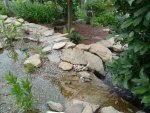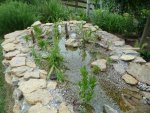Well, I do know that I WILL go with a footer, but not sure about a wall material or construction method -- too confusing at this point!
For simple go with standard building practice. I'd use 3/8" (#3) rebar. Cut vertical pieces that can be stuck into the wet footer and come up to a couple of inches below the top of the wall. The rebar should not push thru the concrete all the way to soil. Rebar should be completely enclosed in concrete. One vertical every other block, or you can add more if you like. I lay the first course in the footer while it's still wet and place the vertical rebar after the concrete sets up a little.
Next day lay the remaining courses, just dry stacked, no mortar. Stagger the vertical joints, calling a "running bond" pattern, like most people thick of bricks. Easy as pie. The top course should be blocks called "bond beam". Every place that sells regular blocks will also have bond beam blocks. In that top course you lay a continuous strand of the #3 rebar horizontally. It make it continuous you overlap 24". You can tie the overlap together with wire sold next to the rebar. They have a tool for twisting the wire but for a small job pliers are fine.
Fill the holes in the blocks with concrete. Let cure 4 weeks. You want temps to be above say 50F.
Pretty easy really especially with such a short wall. For 2' above ground in LA I'd say one course below ground was plenty deep enough, so just 4 courses total would get you nearly 2' above ground. Because it's not high it's tough to get the top too far off level if the first course is pretty level. It's not a house. And dry stacked means it's easier to adjust blocks to get a straight wall.
When you fill I like a pretty dry mix, mash potatoes, not pudding. I put some in and use a stick, like a 1"x1" to pack the concrete in. The less water the stronger the concrete and when dry it basically sets up as you pack it. Less problems.
You will end up with one gap between blocks on each course. When the concrete is poured you can put a piece of wood on either side to keep the concrete in.
If you like you can build the entire thing out of bond beam blocks if you like and place horizontal rebar in as many courses as you like. But for 2' high I'd say the top course was plenty.
This technique is call "core filled dry stacked block". If you Google you'll find a lot about just "dry stacked" where a coat of cement is skimmed over the block on both sides, like stucco. That technique isn't strong enough for your application and isn't needed when the blocks are filled with concrete.






